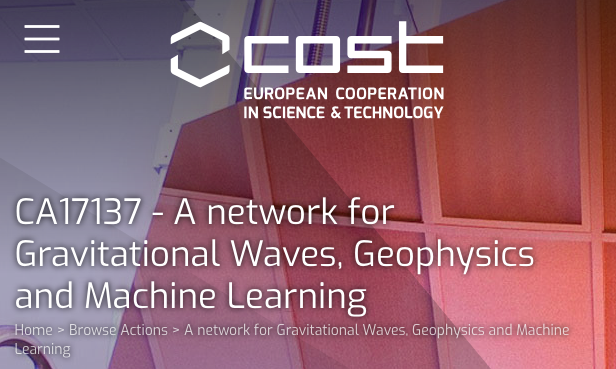IN THE PRESS
- 08/12/2015 - El Mundo (B@leópolis): Las ondas gravitacionales, en caza y captura
- 03/12/2015 - DICYT: 2016 será un gran año en la búsqueda de las ondas gravitacionales
- 23/11/2015 - La fábrica de la ciencia: Ondas gravitacionales,la música del Cosmos
- 19/11/2015 - SINC: A la caza de ondas gravitacionales
- 06/11/2015 - El Cultural: Los investigadores, ante las claves del universo
- 12/09/2015 - BALEARS FA CIÈNCIA (IB3Ràdio): La teoria de la relativitat i les ones gravitacionals Entrevista a les 12h, minut 22:50
- 10/09/2015 - El Mundo (B@leópolis): Una nueva ventana al universo
- 01/09/2015 - CPAN: LISA Pathfinder, en el camino al lanzamiento
- 26/06/2015 - Hipertextual: Este es el reto más importante de la física de la próxima década
- 2/12/2014 - El Mundo (B@leópolis): La banda de los agujeros negros
- 16/11/2014 - Diario de Mallorca: Ciencia en las estrellas del cine
- 1/04/2014 - El Mundo (B@leópolis): La primera foto del universo
- 1/02/2014 - Investigación y ciencia: Seísmos y ondas gravitacionales
- Investigación y Ciencia, February 2014
- 25/11/2009 - SINC: El universo busca la conciliación
- Campus Obert: Física después del bosón de Higgs
- Campus Obert: Intentando escuchar el Universo
- LIGO Flyer: Searching for continuous gravitational wave signals with the Hough transform
- Diario de Mallorca: "Europa destaca una recerca del Grup de Relativitat y Gravitació de la UIB"
- Prace Report 2012
- El Mundo (B@leópolis): "Sinfonía del universo en clave 2.0"
- Cadena Ser (A vivir que son dos días Baleares): Interview
- Diario de Mallorca: "A la recerca dels sons de l'univers"
- El Mundo (B@leópolis): "Relatividad y agujeros negros, contados para todos los públicos"
- ABC: "Una web sobre la relatividad de la UIB gana premio nacional de divulgación"
- Última Hora Column: "Einstein y las enanas blancas"
- Última Hora Column: "Sorprendente Convivencia"
- IB3 Radio Interview: "Descubierto el planeta extrasolar más cercano a la Tierra"
- Diario De Mallorca: "Los GPS tienen en cuenta la Teoría de la Relatividad para fijar la posición"
- Diari De Balears: "¿Hem trobat la partícula de Déu?"
- Diario de Mallorca: "Descubren la partícula que podría explicar el origen del universo"
- RNE Interview: "97 años de teoría de la relatividad"
- El Mundo News: "A la búsqueda del lado más oscuro del Universo"
- Última Hora Column: "Al acecho de la partícula divina"
- Última Hora Column: "Neutrinos con Prisa"
- Diario de Mallorca News: "Superordenadores al alcance de la UIB"
- ABC Interview: "Somos el único grupo español que participa en el proyecto LIGO"
- IB3 TV Interview: "La UIB millora la recerca dels forats negres"
- ABC News: "La UIB desarrolla un método para la detección de los agujeros negros"
- El Mundo News: "Científicos de Barcelona y Baleares participarán en rediseño del observatorio espacial LISA"
Seguir @UIBGRG
UIB in the network for GW, Geophysics and Machine Learning
8 November, 2018

Prof. Alicia M. Sintes from the UIB and Prof. Jose Antonio Font Roda from Valencia University have been elected as new members of the Management Committee of the COST action CA17137 - A network for Gravitational Waves, Geophysics and Machine Learning.
The breakthrough discovery of gravitational waves on September 14, 2015 was made possible through synergy of techniques drawing from expertise in physics, mathematics, information science and computing. At present, there is a rapidly growing interest in Machine Learning (ML), Deep Learning (DL), classification problems, data mining and visualization and, in general, in the development of new techniques and algorithms for efficiently handling the complex and massive data sets found in what has been coined "Big Data", across a broad range of disciplines, ranging from Social Sciences to Natural Sciences. The rapid increase in computing power at our disposal and the development of innovative techniques for the rapid analysis of data will be vital to the exciting new field of Gravitational Wave (GW) Astronomy, on specific topics such as control and feedback systems for next-generation detectors, noise removal, data analysis and data-conditioning tools.The discovery of GW signals from colliding binary black holes (BBH) and the likely existence of a newly observable population of massive, stellar-origin black holes, has made the analysis of low-frequency GW data a crucial mission of GW science. The low-frequency performance of Earth-based GW detectors is largely influenced by the capability of handling ambient seismic noise suppression. This Cost Action aims at creating a broad network of scientists from four different areas of expertise, namely GW physics, Geophysics, Computing Science and Robotics, with a common goal of tackling challenges in data analysis and noise characterization for GW detectors.
COST (European Cooperation in Science and Technology) is a funding organisation for research and innovation networks. COST Actions help connect research initiatives across Europe and beyond and enable researchers and innovators to grow their ideas in any science and technology field by sharing them with their peers. COST Actions are bottom-up networks with a duration of four years that boost research, innovation and careers.







